Luke Skywalker
Super Moderator
The OnePlus 7 Pro is the firm’s largest, most expensive and most premium phone yet. While not that cheap, it still undercuts the competition by some margin, while offering sheer speed and a stunning notchless display that even its most expensive rivals can’t touch.
Starting at £649, the OnePlus 7 Pro is £150 more expensive than last year’s 6T or its 2019 refresh the 7 (non-Pro). It’s also significantly bigger.
The 6.67in QHD+ AMOLED screen is absolutely massive and runs at a refresh rate of 90Hz, meaning the screen updates 90 times per second – which is 50% faster than most phones and a first for an OLED screen. The difference is immediately noticeable, even simply scrolling in apps, web pages and between home screens. You quickly get used to it, of course, until you try to go back to a 60Hz phone.
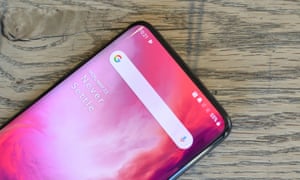
No notches or other interruptions in the screen thanks to the pop-up selfie camera, but there is a thin speaker at the top. Photograph: Samuel Gibbs/The Guardian
The screen is also a seamless slate, with no cut-outs for sensors and selfie cameras. Instead the selfie camera is mounted in a motorised module that pops up from the top of the phone. With curved edges and tiny bezels all round, the OnePlus 7 Pro feels like the end of the road for traditional smartphone design. There’s nothing left on the front but screen.
The rest of the phone is fairly par for the course. There’s a USB-C port in the bottom, a triple camera lump on the back and no headphone socket. The curved glass front meets metal and more curved glass on the back. It’s a simple, attractive look, very reminiscent of Samsung’s phones for the last few years.
Despite the minimal bezels, there’s no getting over how big the OnePlus 7 Pro is: 206g in weight, 162.6mm tall, 75.9mm wide and 8.8mm thick. Huawei’s 6.47in P30 Pro is noticeably narrower at 73.4mm, while the 6.4in Samsung Galaxy S10+ is 74.1mm wide. Both phones are significantly lighter, too, weighing 192g and 175g respectively.
Only Apple’s iPhone XS Max, which is one of the hardest big phones to wield, is wider at 77.4mm and heavier at 208g.
All of that is to say the OnePlus 7 Pro is a stretch to use, right on the limit of what I can hold in one hand and not drop while clinging on to public transport, aided by the curved back and hard metal edge.
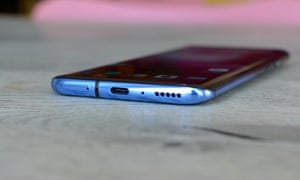
The USB-C port and bottom-firing speaker in the shiny metal frame. Photograph: Samuel Gibbs/The Guardian
The OnePlus 7 Pro is the ultimate enthusiast-pleaser on paper, with its specifications reading like a fanboy wish list. It has Qualcomm’s latest top Snapdragon 855 processor with your choice of 6GB, 8GB or 12GB of RAM; 6GB is good, 8GB is ideal for 2019, and 12GB is total overkill.
But the OnePlus 7 Pro is also the first to use the new, significantly faster UFS 3.0 standard for its 128GB or 256GB of storage instead of the common UFS2.1. The only other phone to use UFS 3.0 is the £1,800 Samsung Galaxy Fold, which isn’t quite ready for prime time. Then there’s the new 90Hz screen and the 135Hz touch sensing rate, which detects your finger input faster.
All combined the OnePlus 7 Pro is, without doubt, the fastest-feeling Android smartphone by some margin. Everything is an instantaneous, buttery-smooth affair. Apps fly along with no hint of lag or stutter anywhere, as do games and everything else.
That’s not to say that other top-end phones are slow, but the OnePlus is faster, smoother and more fluid. It’s a joy to use even for mundane things and very difficult to go back once you have experienced it.
All that speed is backed up by solid but not exceptional battery life of about 28 hours between charges – enough to get you home after a night out or into work the next day without topping up.
That was as my primary device with the usual deluge of email, messages and push notifications, lots of browsing, five hours of Spotify via Bluetooth headphones, watching 60 minutes of offline movies and shooting about 20 photos a day.
Setting the display to 60Hz added about an hour to the battery life. Gaming unsurprisingly had a fairly large effect on battery life.
There’s no wireless charging, but OnePlus’s new Warp 30 cable charging is very fast. A full charge took 75 minutes from dead, but it would hit 80% in about 45 minutes regardless of whether you were using the phone or not. Only Huawei’s 40W fast charging is quicker.
Oxygen OS 9.5
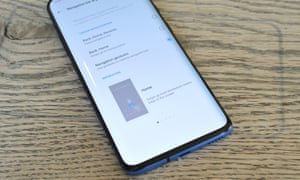
Oxygen OS gives you multiple choices of navigation, plus customisation options for the status bar and many other parts of the system. Photograph: Samuel Gibbs/The Guardian
Oxygen OS 9.5 is OnePlus’s latest version of its customised Android software based on Android 9 Pie, and only features a few small changes since the version 9 on the OnePlus 6T.
Overall Oxygen OS is a refined version of standard Android, with polished elements and a little more customisation, making it one of the best versions of Android currently available. You also get three years of software updates from release.
There’s a choice standard Android navigation keys, Google’s “pill” navigation button or gestures, which are some of the smoothest and best implemented on Android to date – swipe up from the centre to go home, up and hold for recently used apps, or up and over to the right for the previously-used app. The back gesture, up from the left or right bottom edge, is easy to activate by accident – a swipe in from the left or right side of the screen is better.
Oxygen OS also comes with Zen Mode, which locks your phone for 20 minutes of time out, allowing only calls and photos, a gaming mode and a system called RAM boost, which learns which apps you use frequently and pre-caches them into RAM.
The only thing I don’t like about Oxygen OS is the “shelf”, which replaces Google’s Discover feed on the left-most homescreen pane. I don’t find it useful and turn it off. There’s also no real one-handed mode as others such as Huawei include, which for a phone this size would have been helpful.

This is the fastest and most accurate in-screen fingerprint scanner available, finally matching traditional capacitive sensors. Photograph: Samuel Gibbs/The Guardian
The OnePlus 7 Pro has the firm’s second-generation in-display optical fingerprint reader, and it is significantly faster and more accurate than that used in last year’s OnePlus 6T.
While previous versions have been a convenience trade-off versus traditional capacitive sensors, the new in-screen sensor matches them for speed and accuracy. OnePlus has set the new standard; everything else feels slow compared with it.
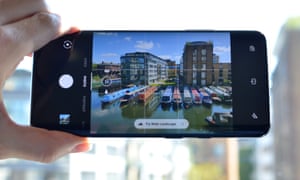
The OnePlus camera app is one of the best and helps to produce good photos in most situations. Photograph: Samuel Gibbs/The Guardian
Cameras have traditionally been a weak point for OnePlus phones. The OnePlus 7 Pro’s triple camera system combining a 48-megapixel main, a 16-megapixel ultra-wide angle and an 8-megapixel telephoto camera is a significant step up.
The primary camera is capable of capturing some really detailed and well-exposed shots. Occasionally it was a little too bright, requiring a bit of adjustment, but even low-light performance was good. The 3x telephoto camera is also good, but produces noticeably more noise in dull lighting than the main camera. The up to 10x digital zoom rivals some of the best, but isn’t in the same league as Huawei’s 50x zoom. The ultra-wide angle camera is great, too, capturing some really interesting shots.
Video quality was generally very good too, but could be a little yellow in indoor lighting. The selfie camera was also capable of capturing some impressive amount of detail that some might find a little too rich.
Overall, the OnePlus 7 Pro has a camera that can keep up with the best from Samsung and Apple, but isn’t quite as good as Huawei’s game-changing P30 Pro in zoom, flexibility or low-light performance.
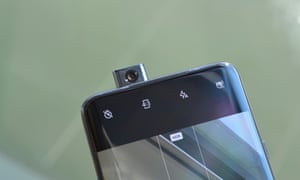
The camera pops up when required, then back into the body when you’re done. If the phone is dropped the camera automatically retracts and pocket-detection stops it unintentionally appearing. Photograph: Samuel Gibbs/The Guardian
The OnePlus 7 Pro costs £649 in black with 6GB of RAM and 128GB of storage. The version with 8GB of RAM and 256GB of storage costs £699 in black or blue, with almond available at a later date. The blue version with 12GB of RAM and 256GB of storage costs £799.
There will also be a 5G version available from EE in the UK on plans starting at £59 a month, and other operators globally.
For comparison, the 128GB OnePlus 7 will cost £499, the 128GB Huawei P30 Pro costs £899, the 128GB Huawei Mate 20 Pro costs £599, the 128GB Samsung Galaxy S10+ costs £899, the 64GB Google Pixel 3 XL costs £869, and the 64GB iPhone XS Max costs £1,099.
The OnePlus 7 Pro is a beast of a phone in every way. It has a genuinely huge screen, making it a really big device. If you don’t like large phones, this is most definitely not for you.
But that huge screen is arguably the best in the industry. It’s so smooth, beautiful and sucks you in like no other. Part of that is the sheer speed and smoothness of the phone, matching the level of polish only Apple and Google have managed, but made faster. Even the optical in-screen fingerprint sensor is super-fast, making everything else feel slow. This is the fastest-feeling smartphone available by some margin.
The camera is really good, too, which is a first for a OnePlus phone. It’s not the best in the business, but it’s no longer left in the dust by top-spec rivals.
It’s not perfect, of course. Battery life is good but not class-leading. There’s no wireless charging, which is pretty disappointing given the price, despite the fast wired charging. There’s no formal water resistance rating, no expandable storage and no headphone socket. And did I mention just how massive this phone is?
But what you get with the OnePlus 7 Pro is a phone that undercuts rivals on price and offers a better experience in almost every meaningful way. The OnePlus 7 Pro is a massive phone worth stretching for.
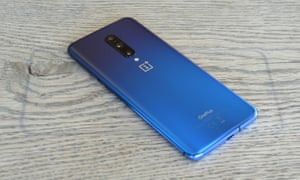
The nebula blue back is really lovely. Photograph: Samuel Gibbs/The Guardian
This article contains affiliate links, which means we (The Guardian) may earn a small commission if a reader clicks through and makes a purchase. All our journalism is independent and is in no way influenced by any advertiser or commercial initiative. By clicking on an affiliate link, you accept that third-party cookies will be set. More information.

Continue reading...
Starting at £649, the OnePlus 7 Pro is £150 more expensive than last year’s 6T or its 2019 refresh the 7 (non-Pro). It’s also significantly bigger.
The 6.67in QHD+ AMOLED screen is absolutely massive and runs at a refresh rate of 90Hz, meaning the screen updates 90 times per second – which is 50% faster than most phones and a first for an OLED screen. The difference is immediately noticeable, even simply scrolling in apps, web pages and between home screens. You quickly get used to it, of course, until you try to go back to a 60Hz phone.

No notches or other interruptions in the screen thanks to the pop-up selfie camera, but there is a thin speaker at the top. Photograph: Samuel Gibbs/The Guardian
The screen is also a seamless slate, with no cut-outs for sensors and selfie cameras. Instead the selfie camera is mounted in a motorised module that pops up from the top of the phone. With curved edges and tiny bezels all round, the OnePlus 7 Pro feels like the end of the road for traditional smartphone design. There’s nothing left on the front but screen.
The rest of the phone is fairly par for the course. There’s a USB-C port in the bottom, a triple camera lump on the back and no headphone socket. The curved glass front meets metal and more curved glass on the back. It’s a simple, attractive look, very reminiscent of Samsung’s phones for the last few years.
Despite the minimal bezels, there’s no getting over how big the OnePlus 7 Pro is: 206g in weight, 162.6mm tall, 75.9mm wide and 8.8mm thick. Huawei’s 6.47in P30 Pro is noticeably narrower at 73.4mm, while the 6.4in Samsung Galaxy S10+ is 74.1mm wide. Both phones are significantly lighter, too, weighing 192g and 175g respectively.
Only Apple’s iPhone XS Max, which is one of the hardest big phones to wield, is wider at 77.4mm and heavier at 208g.
All of that is to say the OnePlus 7 Pro is a stretch to use, right on the limit of what I can hold in one hand and not drop while clinging on to public transport, aided by the curved back and hard metal edge.
Screen: 6.67in 90Hz QHD+ AMOLED (516ppi)
Processor: Qualcomm Snapdragon 855
RAM: 6, 8 or 12GB of RAM
Storage: 128 or 256GB (UFS 3.0)
Operating system: Oxygen OS 9.5 based on 9 Pie
Camera: triple rear camera 48MP, 16MP ultra-wide angle, 8MP telephoto, 16MP front-facing camera
Connectivity: LTE, dual sim, wifiac, NFC, Bluetooth 5 and GPS
Dimensions: 162.6 x 75.9 x 8.8mm
Weight: 206g

The USB-C port and bottom-firing speaker in the shiny metal frame. Photograph: Samuel Gibbs/The Guardian
The OnePlus 7 Pro is the ultimate enthusiast-pleaser on paper, with its specifications reading like a fanboy wish list. It has Qualcomm’s latest top Snapdragon 855 processor with your choice of 6GB, 8GB or 12GB of RAM; 6GB is good, 8GB is ideal for 2019, and 12GB is total overkill.
But the OnePlus 7 Pro is also the first to use the new, significantly faster UFS 3.0 standard for its 128GB or 256GB of storage instead of the common UFS2.1. The only other phone to use UFS 3.0 is the £1,800 Samsung Galaxy Fold, which isn’t quite ready for prime time. Then there’s the new 90Hz screen and the 135Hz touch sensing rate, which detects your finger input faster.
All combined the OnePlus 7 Pro is, without doubt, the fastest-feeling Android smartphone by some margin. Everything is an instantaneous, buttery-smooth affair. Apps fly along with no hint of lag or stutter anywhere, as do games and everything else.
That’s not to say that other top-end phones are slow, but the OnePlus is faster, smoother and more fluid. It’s a joy to use even for mundane things and very difficult to go back once you have experienced it.
All that speed is backed up by solid but not exceptional battery life of about 28 hours between charges – enough to get you home after a night out or into work the next day without topping up.
That was as my primary device with the usual deluge of email, messages and push notifications, lots of browsing, five hours of Spotify via Bluetooth headphones, watching 60 minutes of offline movies and shooting about 20 photos a day.
Setting the display to 60Hz added about an hour to the battery life. Gaming unsurprisingly had a fairly large effect on battery life.
There’s no wireless charging, but OnePlus’s new Warp 30 cable charging is very fast. A full charge took 75 minutes from dead, but it would hit 80% in about 45 minutes regardless of whether you were using the phone or not. Only Huawei’s 40W fast charging is quicker.
Oxygen OS 9.5

Oxygen OS gives you multiple choices of navigation, plus customisation options for the status bar and many other parts of the system. Photograph: Samuel Gibbs/The Guardian
Oxygen OS 9.5 is OnePlus’s latest version of its customised Android software based on Android 9 Pie, and only features a few small changes since the version 9 on the OnePlus 6T.
Overall Oxygen OS is a refined version of standard Android, with polished elements and a little more customisation, making it one of the best versions of Android currently available. You also get three years of software updates from release.
There’s a choice standard Android navigation keys, Google’s “pill” navigation button or gestures, which are some of the smoothest and best implemented on Android to date – swipe up from the centre to go home, up and hold for recently used apps, or up and over to the right for the previously-used app. The back gesture, up from the left or right bottom edge, is easy to activate by accident – a swipe in from the left or right side of the screen is better.
Oxygen OS also comes with Zen Mode, which locks your phone for 20 minutes of time out, allowing only calls and photos, a gaming mode and a system called RAM boost, which learns which apps you use frequently and pre-caches them into RAM.
The only thing I don’t like about Oxygen OS is the “shelf”, which replaces Google’s Discover feed on the left-most homescreen pane. I don’t find it useful and turn it off. There’s also no real one-handed mode as others such as Huawei include, which for a phone this size would have been helpful.

This is the fastest and most accurate in-screen fingerprint scanner available, finally matching traditional capacitive sensors. Photograph: Samuel Gibbs/The Guardian
The OnePlus 7 Pro has the firm’s second-generation in-display optical fingerprint reader, and it is significantly faster and more accurate than that used in last year’s OnePlus 6T.
While previous versions have been a convenience trade-off versus traditional capacitive sensors, the new in-screen sensor matches them for speed and accuracy. OnePlus has set the new standard; everything else feels slow compared with it.

The OnePlus camera app is one of the best and helps to produce good photos in most situations. Photograph: Samuel Gibbs/The Guardian
Cameras have traditionally been a weak point for OnePlus phones. The OnePlus 7 Pro’s triple camera system combining a 48-megapixel main, a 16-megapixel ultra-wide angle and an 8-megapixel telephoto camera is a significant step up.
The primary camera is capable of capturing some really detailed and well-exposed shots. Occasionally it was a little too bright, requiring a bit of adjustment, but even low-light performance was good. The 3x telephoto camera is also good, but produces noticeably more noise in dull lighting than the main camera. The up to 10x digital zoom rivals some of the best, but isn’t in the same league as Huawei’s 50x zoom. The ultra-wide angle camera is great, too, capturing some really interesting shots.
Video quality was generally very good too, but could be a little yellow in indoor lighting. The selfie camera was also capable of capturing some impressive amount of detail that some might find a little too rich.
Overall, the OnePlus 7 Pro has a camera that can keep up with the best from Samsung and Apple, but isn’t quite as good as Huawei’s game-changing P30 Pro in zoom, flexibility or low-light performance.

The camera pops up when required, then back into the body when you’re done. If the phone is dropped the camera automatically retracts and pocket-detection stops it unintentionally appearing. Photograph: Samuel Gibbs/The Guardian
It looks really good in blue, but even better in the limited edition almond
There’s a sharp edge in the bottom corners of the phone where the glass meets the metal
Auto-brightness often went too dim in normal indoor lighting requiring manual correction
It was too easy to invoke the pin code entry screen when shooting photos while the phone was locked
The new motion wallpapers are gorgeous
OnePlus’s alert slider, toggling between silent, vibrate and ring, continues to be excellent
The stereo speakers are some of the best
There’s a 5G version available too
The OnePlus 7 Pro costs £649 in black with 6GB of RAM and 128GB of storage. The version with 8GB of RAM and 256GB of storage costs £699 in black or blue, with almond available at a later date. The blue version with 12GB of RAM and 256GB of storage costs £799.
There will also be a 5G version available from EE in the UK on plans starting at £59 a month, and other operators globally.
For comparison, the 128GB OnePlus 7 will cost £499, the 128GB Huawei P30 Pro costs £899, the 128GB Huawei Mate 20 Pro costs £599, the 128GB Samsung Galaxy S10+ costs £899, the 64GB Google Pixel 3 XL costs £869, and the 64GB iPhone XS Max costs £1,099.
The OnePlus 7 Pro is a beast of a phone in every way. It has a genuinely huge screen, making it a really big device. If you don’t like large phones, this is most definitely not for you.
But that huge screen is arguably the best in the industry. It’s so smooth, beautiful and sucks you in like no other. Part of that is the sheer speed and smoothness of the phone, matching the level of polish only Apple and Google have managed, but made faster. Even the optical in-screen fingerprint sensor is super-fast, making everything else feel slow. This is the fastest-feeling smartphone available by some margin.
The camera is really good, too, which is a first for a OnePlus phone. It’s not the best in the business, but it’s no longer left in the dust by top-spec rivals.
It’s not perfect, of course. Battery life is good but not class-leading. There’s no wireless charging, which is pretty disappointing given the price, despite the fast wired charging. There’s no formal water resistance rating, no expandable storage and no headphone socket. And did I mention just how massive this phone is?
But what you get with the OnePlus 7 Pro is a phone that undercuts rivals on price and offers a better experience in almost every meaningful way. The OnePlus 7 Pro is a massive phone worth stretching for.
Pros: stunning screen, super-fast performance, fast in-screen fingerprint reader, good battery life, dual-sim, really good camera, great software, alert slider
Cons: glass back but no wireless charging, no IP water resistance rating, no expandable storage, no headphone socket, too big

The nebula blue back is really lovely. Photograph: Samuel Gibbs/The Guardian
Huawei P30 Pro review: game-changing camera, stellar battery life
Samsung Galaxy S10+ review: a simply stunning screen
This article contains affiliate links, which means we (The Guardian) may earn a small commission if a reader clicks through and makes a purchase. All our journalism is independent and is in no way influenced by any advertiser or commercial initiative. By clicking on an affiliate link, you accept that third-party cookies will be set. More information.
Continue reading...
